Cause of death Lung cancer Name Yul Brynner Occupation Actor Role Film actor | Years active 1941–1985 Height 1.73 m Religion Russian Orthodox | |
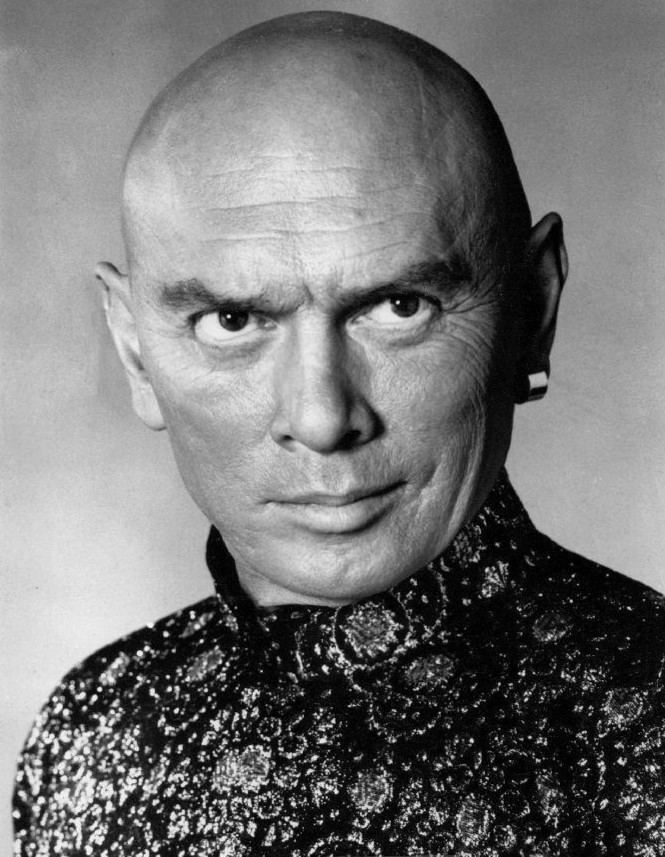 | ||
Full Name Yuliy Borisovich Briner Born July 11, 1920 ( 1920-07-11 ) Vladivostok, Far Eastern Republic (present-day Vladivostok, Russia) Resting place Saint-Michel-de-Bois-Aubry Russian Orthodox Monastery near Luze, France Died October 10, 1985, New York City, New York, United States Spouse Kathy Lee (m. 1983–1985) Children Victoria Brynner, Yul 'Rock' Brynner II, Lark Brynner, Mia Brynner, Melody Brynner Movies The Magnificent Seven, The King and I, The Ten Commandments, Westworld, Anastasia Similar People Charles Bronson, Deborah Kerr, Steve McQueen, Charlton Heston, James Coburn | ||
The hollywood collection yul brynner the man who was king
Yul Brynner (born Yuliy Borisovich Briner, Russian: Юлий Борисович Бринер; July 11, 1920 – October 10, 1985) was a Russian-born film and stage actor.
Contents
- The hollywood collection yul brynner the man who was king
- Yul brynner the man who was king
- Early life
- World War Two
- Broadway
- The King and I
- Film Stardom
- The Magnificent Seven
- Box Office Decline
- Later Films
- Photographer author and musician
- Personal life
- Citizenship
- Illness and death
- Awards
- Honors
- Other
- Filmography
- Box office ranking
- Select stage work
- References
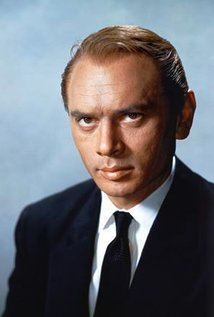
Brynner was best known for his portrayal of King Mongkut of Siam in the Rodgers and Hammerstein musical The King and I, for which he won two Tony Awards and an Academy Award for the film version. He played the role 4,625 times on stage. He also starred as Ramesses II in the 1956 Cecil B. DeMille blockbuster The Ten Commandments, and played General Bounine in the 1956 film Anastasia, and the gunman Chris Adams in The Magnificent Seven.
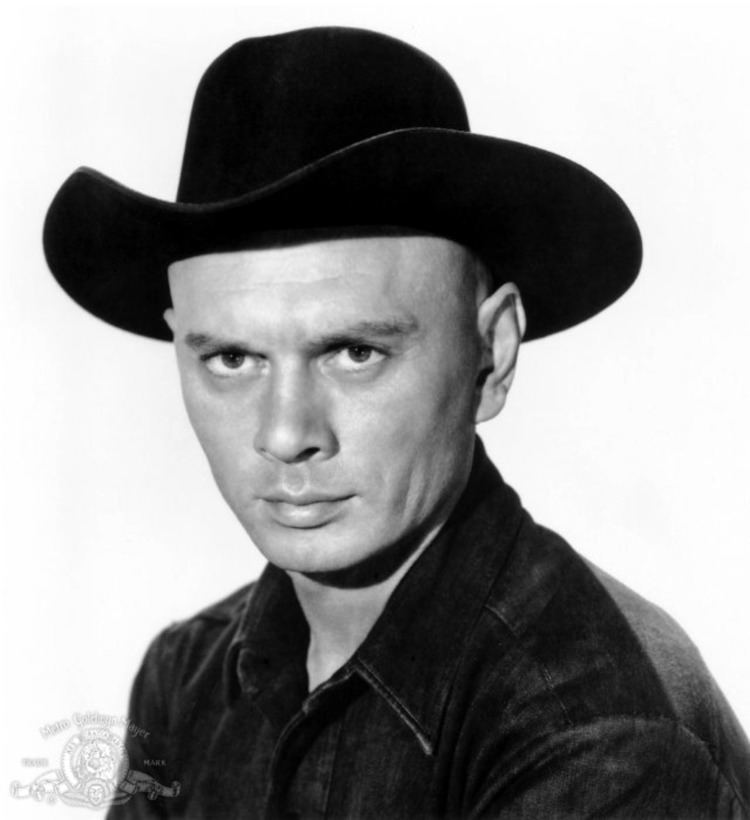
Brynner was noted for his distinctive voice and for his shaved head, which he maintained as a personal trademark long after adopting it in 1951 for his role in The King and I. Earlier, he was a model and television director, and later a photographer and the author of two books.
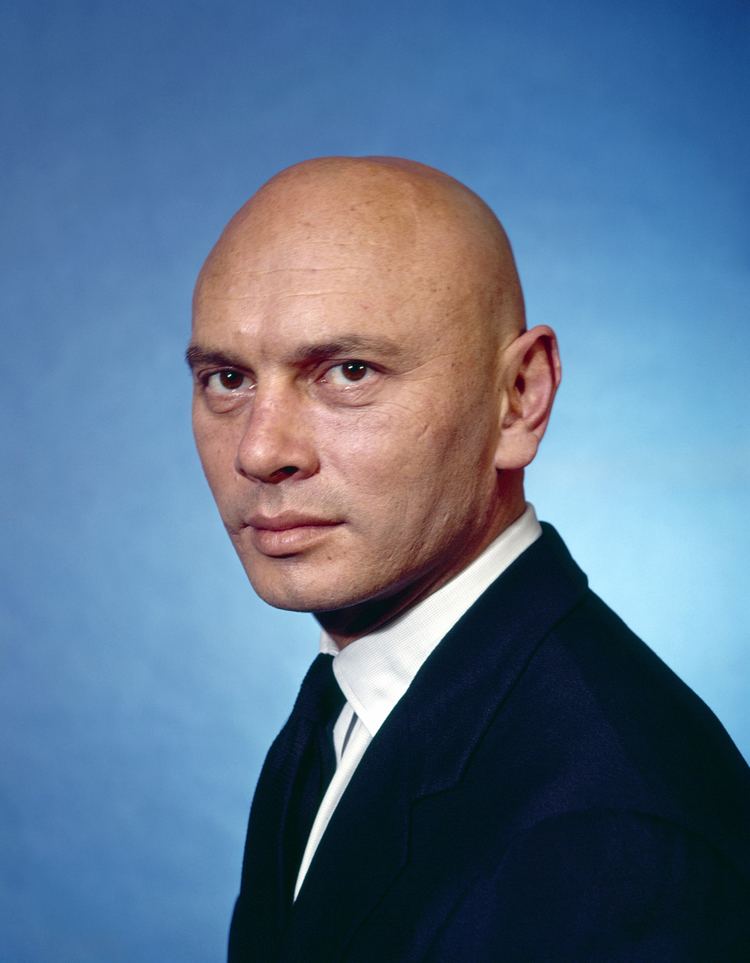
Yul brynner the man who was king
Early life

Yul Brynner was born Yuliy Borisovich Briner July 11, 1920 in Vladivostok, Far Eastern Republic (present-day Primorsky Krai, Russia). He enjoyed telling tall tales and exaggerating his background and early life for the press, claiming that he was born "Taidje Khan" of part-Mongol parentage, on the Russian island of Sakhalin. In reality of Swiss-German, Russian, and partial Buryat ancestry, he was born at home in a four-story residence at 15 Aleutskaya Street, Vladivostok. He had an elder sister, Vera. He occasionally referred to himself as Julius Briner, Jules Bryner or Youl Bryner. The 1989 biography by his son, Rock Brynner, clarified some of these issues.

His father, Boris Yuliyevich Briner, was a mining engineer and inventor of Swiss-German and Russian descent, whose father, Jules Briner, was a Swiss citizen who moved to Vladivostok in the 1870s and established a successful import/export company. Brynner's paternal grandmother, Natalya Yosifovna Kurkutova, was a native of Irkutsk and a Eurasian of part Buryat ancestry. Brynner's mother, Marousia Dimitrievna (née Blagovidova), came from the Russian intelligentsia and studied to be an actress and singer. Brynner felt a strong personal connection to the Romani people; in 1977, Brynner was named honorary president of the International Romani Union, an office that he kept until his death.
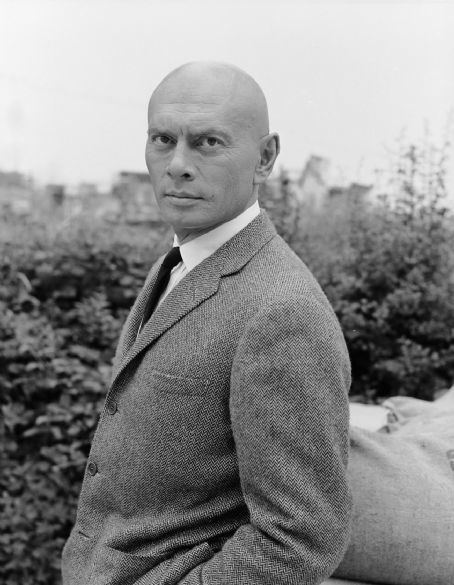
Boris Briner's work required extensive travel, and in 1923, he fell in love with an actress, Katya Kornukova, at the Moscow Art Theatre, and soon after abandoned his family. Yul's mother took his elder sister, Vera (January 17, 1916 – December 13, 1967), and him to Harbin, China, where they attended a school run by the YMCA.

In 1932, fearing a war between China and Japan, she took them to Paris. Brynner played his guitar in Russian nightclubs in Paris, sometimes accompanying his sister, playing Russian and Roma songs. He trained as a trapeze acrobat and worked in a French circus troupe for five years, but after sustaining a back injury, he turned to acting. In 1938, his mother was diagnosed with leukemia, and they briefly moved back to Harbin.
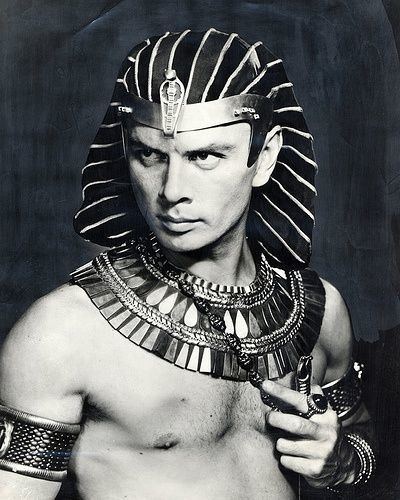
In 1940, speaking little English, he and his mother emigrated to the United States aboard the President Cleveland, arriving in New York City on October 25, 1940, where his sister already lived. Vera, a singer, starred in The Consul on Broadway in 1950 and appeared at The Metropolitan Opera as Prince Orlofsky in Die Fledermaus and on television in the title role of Carmen. She later taught voice in New York.
World War Two
During World War II, Brynner worked as a French-speaking radio announcer and commentator for the US Office of War Information, broadcasting to occupied France. At the same time, he studied acting in Connecticut with the Russian teacher Michael Chekhov.
Broadway
Brynner's first Broadway performance was a small part in Shakespeare's Twelfth Night in December 1941. Brynner found little acting work during the next few years, but among other acting stints, he co-starred in a 1946 production of Lute Song with Mary Martin. He also did some modelling work and was photographed nude by George Platt Lynes.
Brynner's first marriage was to actress Virginia Gilmore in 1944, and soon after he began working as a director at the new CBS television studios, directing Studio One, among other shows. He made his film debut in Port of New York released in November 1949.
The King and I
The next year, at the urging of Martin, he auditioned for Rodgers and Hammerstein's new musical in New York. He recalled that, as he was finding success as a director on television, he was reluctant to go back on the stage. Once he read the script, however, he was fascinated by the character of the King and was eager to perform in the project.
His role as King Mongkut in The King and I (4,625 times on stage) became his best known role. He appeared in the original 1951 production and later touring productions, as well as a 1977 Broadway revival, a London production in 1979, and another Broadway revival in 1985. He won Tony Awards for both the first and the last of these Broadway productions. He also appeared in the 1956 film version, for which he won an Academy Award as Best Actor and in Anna and the King, a short-lived TV version on CBS in 1972. Brynner is one of only eight people who have won both a Tony and an Academy Award for the same role. His connection to the story and the role of King Mongkut is so deep that he was mentioned in the song "One Night in Bangkok", from the 1984 musical Chess, the second act of which is set in Bangkok.
In 1951, Brynner shaved his head for his role in The King and I. Following the huge success of the Broadway production and subsequent film, Brynner continued to shave his head for the rest of his life, though he wore a wig for certain roles. Brynner's shaven head was unusual at the time, and his striking appearance helped to give him an exotic appeal. Some fans shaved off their hair to imitate him, and a shaven head was often referred to as the "Yul Brynner look". Brynner reprised his "Shall We Dance?" segment with Patricia Morison on the TV special General Foods 25th Anniversary Show: A Salute to Rodgers and Hammerstein, broadcast March 28, 1954 on all four American TV networks of the time.
Film Stardom
Brynner's second film was the film version of The King and I (1956) with Deborah Kerr. It was a huge success critically and commercially.
Cecil B. de Mille hired him for The Ten Commandments (1956) to play Ramesses II opposite Charlton Heston. He rounded out his year with Anastasia (1956) co starring with Ingrid Bergman under the direction of Anatole Litvak. Both films were big hits and Brynner became one of the most in-demand stars in Hollywood.
MGM cast him as one of The Brothers Karamazov (1957), which was another commercial success. Less so was The Buccaneer (1958) in which Brynner played Jean Lafitte; he co-starred with Heston and the film was produced by De Mille but directed by Anthony Quinn.
MGM used Brynner again in The Journey (1959), opposite Kerr under the direction of Litvak, but the film lost money. So too did The Sound and the Fury (1959) based on the novel by William Faulkner with Joanne Woodward.
However Brynner then received an offer to replace Tyrone Power who had died during the making of Solomon and Sheba (1959) with Gina Lollobrigida. The movie was a huge hit. It did mean though that a proposed Brynner film about Spartacus had to be postponed; when the Kirk Douglas film came out Brynner elected not to make it.
Brynner tried comedy with two films directed by Stanley Donen: Once More, with Feeling! (1960) and Surprise Package (1960) but public response was underwhelming. He made a cameo in Testament of Orpheus (1960).
The Magnificent Seven
The public did like The Magnificent Seven (1960) a Western remake of Seven Samuraifor the Mirisch Brothers. It was a box office disappointment on initial release in the US but proved hugely popular in Europe and was very durable. It led to Brynner signing a three-picture deal with the Mirisches. He made a cameo in Goodbye Again (1961).
Box Office Decline
Brynner focused on action films. He did Escape from Zahrain (1962) with Ronald Neame and Taras Bulba (1962) with Tony Curtis for J. Lee Thompson. Both films were commercial disappointments; Taras Bulba was popular but failed to recoup its large cost.
The first film under his three-picture deal with Mirisch was Flight from Ashiya (1963) with George Chakiris. It was followed by Kings of the Sun (1963), also with Chakiris, directed by Thompson. Neither film was particularly popular; not was Invitation to a Gunfighter (1964), a Western.
Morituri (1965), opposite Marlon Brando, failed to reverse the series of unsuccessful movies. He had cameos in Cast a Giant Shadow (1966) and The Poppy Is Also a Flower (1966).
Brynner enjoyed his first hit in a number of years with Return of the Seven (1966), reprising his role from the original. Less popular was Triple Cross (1966), a war movie with Christopher Plummer; The Double Man (1967), a spy thriller; The Long Duel (1967), an Imperial adventure tale opposite Trevor Howard; Villa Rides (1968), a Western; and The File of the Golden Goose (1969).
Brynner went to Yugoslavia to appear in a war film, Battle of Neretva (1969). He supported Katherine Hepburn in the big budget flop The Madwoman of Chaillot (1969). Brynner appeared in drag (as a torch singer) in an unbilled role in the Peter Sellers comedy The Magic Christian (1969).
Later Films
Brynner went to Italy to make a spaghetti western, Adiós, Sabata (1970) and supported Kirk Douglas in The Light at the Edge of the World (1971). He remained in lead roles for Romance of a Horsethief (1971) and a Western Catlow (1971).
Brynner had a small role in Fuzz (1972) then reprised his most famous part in the TV series Anna and the King (1972) which ran for 12 episodes.
After Night Flight from Moscow (1973) in Europe, Brynner had his first hit in years with Westworld (1973). Brynner's next two films were variations on this performance: The Ultimate Warrior (1975) and Futureworld (1976).
Brynner returned to Broadway in Home Sweet Homer, a notorious flop musical. His final movie was Death Rage (1976), an Italian action film.
Photographer, author and musician
In addition to his work as a director and performer, Brynner was an active photographer and wrote two books. His daughter Victoria put together Yul Brynner: Photographer (ISBN 0-8109-3144-3), a collection of his photographs of family, friends, and fellow actors, as well as those he took while serving as a UN special consultant on refugees. Brynner wrote Bring Forth the Children: A Journey to the Forgotten People of Europe and the Middle East (1960), with photographs by himself and Magnum photographer Inge Morath, and The Yul Brynner Cookbook: Food Fit for the King and You (1983 ISBN 0-8128-2882-8).
He was also an accomplished guitarist. In his early period in Europe, he often played and sang gypsy songs in Parisian nightclubs with Aliosha Dimitrievitch. He sang some of those same songs in the film The Brothers Karamazov. In 1967, Dimitrievitch and he released a record album The Gypsy and I: Yul Brynner Sings Gypsy Songs (Vanguard VSD 79265).
Personal life
Brynner married four times. The first three marriages ended in divorce. He fathered three children and adopted two. His first wife was actress Virginia Gilmore (1944–1960) with whom he had one child, Rock Yul Brynner (born December 23, 1946). His father nicknamed him "Rock" when he was six years old in honor of boxer Rocky Graziano. Rock is a historian, novelist, and university history lecturer at Marist College in Poughkeepsie, New York and Western Connecticut State University in Danbury, Connecticut.
In 2006, Rock wrote a book about his father and his family history titled Empire and Odyssey: The Brynners in Far East Russia and Beyond. He regularly returned to Vladivostok, the city of his father's birth, for the "Pacific Meridian" Film Festival. Yul Brynner had a long affair with Marlene Dietrich, who was 19 years his senior, beginning during the first production of The King and I.
In 1959, Brynner fathered a daughter, Lark Brynner, with Frankie Tilden, who was 20 years old. Lark lived with her mother and Brynner supported her financially. His second wife, from 1960 to 1967, Doris Kleiner, was a Chilean model whom he married on the set during shooting of The Magnificent Seven in 1960. They had one child, Victoria Brynner (born November 1962), whose godmother was Audrey Hepburn. Belgian novelist and artist Monique Watteau was also romantically linked with Brynner, from 1961–1967.
His third wife, Jacqueline Thion de la Chaume (1971–1981), a French socialite, was the widow of Philippe de Croisset (son of French playwright Francis de Croisset and a publishing executive). Brynner and Jacqueline adopted two Vietnamese children: Mia (1974) and Melody (1975). The first house Brynner owned was the Manoir de Criqueboeuf, a 16th-century manor house that Jacqueline and he purchased. His 1980 announcement that he would continue in the role of the King for another long tour and Broadway run, together with his affairs with female fans and his neglect of his wife and children, purportedly broke up this marriage.
On April 4, 1983, aged 62, Brynner married his fourth and final wife, Kathy Lee (born 1957), a 24-year-old ballerina from Ipoh, Malaysia, whom he had met in a production of The King and I . They remained married for the last two years of his life.
Citizenship
Brynner, a Swiss citizen, was naturalized as a U.S. citizen after applying in 1943, at the age of 22, while living in New York as an actor and radio announcer. However, in June 1965, he renounced his US citizenship at the U.S. Embassy in Berne, Switzerland, for tax reasons. He had lost his tax exemption as an American resident abroad by working too long in the United States and would have been bankrupted by his tax and penalty debts.
Illness and death
Brynner began smoking heavily at age 12, and although his promotional photos often showed him with a cigarette in hand, he quit the habit in 1971. In September 1983, he found a lump on his vocal cords. In Los Angeles, only hours before his 4,000th performance in The King and I, he received the test results indicating that while his throat was fine, he had inoperable lung cancer. He and the national tour of the musical were forced to take a few months off while he underwent radiation therapy, which hurt his throat and made it impossible for him to sing or speak easily. The tour then resumed.
In January 1985, nine months before his death, the tour reached New York for a farewell Broadway run. Aware he was dying, he gave an interview on Good Morning America discussing the dangers of smoking and expressing his desire to make an anti-smoking commercial. The Broadway production of The King and I ran from January 7 to June 30 of that year, with Mary Beth Peil as Anna. His last performance marked the 4625th time he had played the role of the King. Meanwhile, Brynner and the American Cancer Society created a public service announcement using a clip from the Good Morning America interview.
Brynner died of lung cancer on October 10, 1985, in New York City. A few days after his death, the recorded anti-cigarette public service announcement was shown on all the major US television networks and in many other countries. In it, he expressed his desire to make an anti-smoking commercial after discovering how sick he was, and that his death was imminent. He then looked directly into the camera for 30 seconds and said, "Now that I'm gone, I tell you: Don't smoke. Whatever you do, just don't smoke. If I could take back that smoking, we wouldn't be talking about any cancer. I'm convinced of that."
His body was buried in the grounds of the Saint-Michel-de-Bois-Aubry Orthodox monastery, near Luzé, between Tours and Poitiers in France (47.009N, 0.486E).
Awards
Honors
On September 28, 2012, a 2.4-m-tall statue was inaugurated at Yul Brynner Park, in front of the home where he was born at Aleutskaya St. No. 15 in Vladivostok, Russia. Created by local sculptor Alexei Bokiy, the monument was carved in granite from China. The grounds for the park were donated by the city of Vladivostok, which also paid additional costs. Vladivostok Mayor Igor Pushkariov, US Consul General Sylvia Curran, and Yul's son, Rock Brynner, participated in the ceremony, along with hundreds of local residents.
Other
Filmography
Short subjects
Box office ranking
At the height of his career Yul Brynner was voted by exhibitors as among the most popular stars at the box office:
